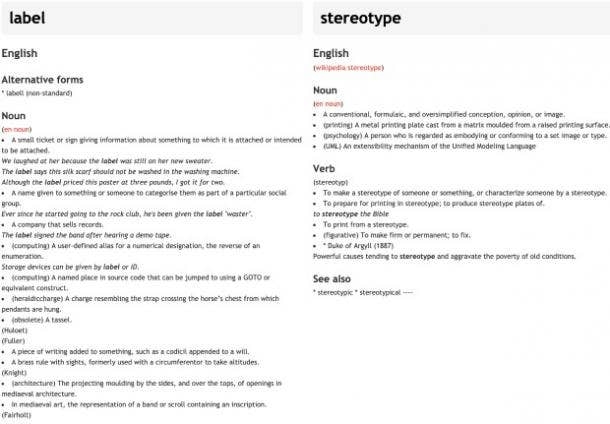
Describing yourself is rarely easy, but this will help you out.
By Ruth Schimel, PhD — Written on Dec 28, 2019
Photo: KAL VISUALS on Unsplash

Springing the trap, so to speak, by describing ourselves and others accurately and fully takes attention and time.
Maybe that’s why many of us often default to using labels and stereotypes when attempting to capture ourselves or others in just a few words. I even catch myself doing this when describing others and myself.
Whether they are applied to families and friends, communities and colleagues, or potential love Interests, minimizing descriptions are frequently substituted for an appreciation of what makes someone unique, special, or merely complex.
What are stereotypes vs. labels?
Labels and stereotypes are different, but can bleed into one another.
RELATED: 10 Stereotypes About Men & Women That Keep People From Finding True Love
Both often stop observers from taking in new, possibly contradictory information, especially when they prefer neatness, predictability, or comfort to complexity.
To distinguish between the two, here’s a brief side-by-side comparison.
 Photo credit: Wikidiff
Photo credit: Wikidiff
When you want to give anyone or a situation fuller measure to benefit others and yourself, here’s one way to catch yourself using what seems an efficient, yet limiting, label or the more dangerous stereotype.
Be alert to a quick, automatic association that has more to do with your own assumptions and experiences than the actual person or situation at hand.
You may not even be conscious of that immediate “click” in your mind that distracts from a more expansive appreciation, especially in today’s rapid response ethos.
To counter any impulse to get a quick focus about an individual that may lead to a limiting label or stereotyping, I turn to philosopher Friedrich Nietzsche’s insight about generating our more powerful selves.
"In his heart," Nietzsche wrote, "every man knows quite well that, being unique, he will be in the world only once and that no imaginable chance will for a second time gather together into a unity so strangely variegated an assortment as he is: he knows it but he hides it like a bad conscience — why? From fear of his neigbor, who demands conventionality and cloaks himself with it.
"But what is it that constrains the individual to fear his neighbor, to think and act like a member of a herd, and to have no joy in himself? Modesty, perhaps, in a few rare cases. With the great majority it is indolence, inertia, in short that tendency to laziness of which the traveler spoke. He is right: men are even lazier than they are timid, and fear most of all the inconveniences with which unconditional honesty and nakedness would burden them."
Fear and laziness, he explains, are constraints that tie us down.
People build walls around their own minds, and even in front of their own eyes.
Instead, benefit from curiosity about your own potential and others’ possibilities. Staying open can offset the inhibitions and limitations that stereotypes and labels impose.
RELATED: 4 Struggles You Probably Have No Idea Asian-American Women Face Every Single Day
Creating bridges
Yet sometimes using labels just seems simpler. Typical examples could relate to categories such as gender, age, and work.
But in today’s world, notice which ones may be simplistic or narrow, limiting openness to collaborations and other worthwhile relationships. An alternative is to imagine the range of productive, positive possibilities and associations related to any label and even to a stereotype.
That view could nudge open doors to adventure and acknowledges the richness of a range of realities.
Take gender, for example.
When I studied biology in high school, I was surprised to find out about the evolution of the fetus. A human fetus does not develop its external sex organs until seven weeks after fertilization and hormones start prompting the growth of organs identifiable as male or female.
In addition to physiological aspects, which can sometimes be ambiguous at birth, there are myriad sociological and psychological influences after birth. These days, the varieties are becoming more obvious and accepted. Some roles are fluid or changeable, but the majority relate to conventional definitions of male and female.
Out of curiosity about gender roles, you may want to take the Bem Sex-Role Inventory (BSRI), which measures how people's personalities may reflect gender.
When I took it a while back, I was not surprised to learn I possess both “masculine” and “feminine”-identified personality traits. That did not surprise me because my parents encouraged assertive and aesthetic tendencies, logical and nonlinear thinking, caring and tough-minded behavior.
Perhaps take the inventory with some trusted friends with whom you can enjoy discussing the outcomes you all have.
This is just a short excursion to a range of gender views and assumptions, about which thousands of books and articles have been and continue to be written.
One recent book you may find interesting is Gina Rippon’s "Gender and Our Brains: How New Neuroscience Explodes the Myths of the Male and Female Minds."
RELATED: What It's Really Like To Be A Guy With A Female Brain
Appreciating your authentic identity
While this topic is on your mind, appreciate your range of identity further right now.
Without overthinking, take a few minutes to list seven to ten ways to briefly describe your identity, regardless of gender. Use nouns, verbs, adjectives, adverbs, and short phrases.
For deeper insight, try creating one positive list and one that has negative or limiting connotations.
Examples of positive attributes could include mature, intelligent, disciplined, interested in others’ welfare, and willingness to learn.
Examples of limiting tendencies could include insecure, unwilling to ameliorate unhealthy habits, and lacking empathy.
Then there are all the “messy” or more ambiguous, in-between ranges from nosy to curious, from discomfort with change to willingness to learn from errors and mistakes.
See how problematic labels and stereotypes can be?
Even naming them can quickly lead into loopy thinking, natural ambiguities, and temporary dilemmas.
Another problem is that parking labels and stereotypes on anyone robs yourself and others of hope and possibilities, especially when such boundaries become set.
They also lead to self-fulfilling prophecies. That stimulates the very behaviors that reflect the assumptions behind them. So, the process of exploring ranges of behavioral descriptions about who you and others are can be pretty dynamic and complicated.
Given the challenges and dangers, I think it’s still valuable to bother.
Making patience pay
I believe it’s beneficial and important to keep clarifying and expanding the descriptive words you choose to use because they help to create and appreciate accurate, more inspiriting identities.
They also influence how you act and perceive others, as well as what you have in common.
Ultimately, such self-awareness, openness, and clarity improve the likelihood of being as comfortable, confident, and powerful as possible for everyone. That process also encourages authentic relationships and trust-building.
Easier said than done, you may think. Given individuals’ unique capacities, the flow of experiences, external influences, and the continuing motion and emotions of daily living, how can you settle on a static vision anyway? Who has the time to think about all that? It may seem there are too many variables to capture in descriptions, even considering a range!
And realistically, there is probably no “there, there,” because truly knowing yourself and others is a process of continuing adjustments and brightening clarity.
Yet I still think the bottom line is that investing in your own growth, self-appreciation, and understanding of others has great value.
No one else has your particular insight, choice, and foundation for doing that as well as you can, in fact!
RELATED: 6 Ways Wise Parents Fight Back Against Toxic Gender Stereotypes
Keeping your investment in your authentic identity vital
You can add pleasure to this process by exploring nonverbal ways to see yourself and others.
Related Stories From YourTango:
What would a mobile or another visual representation suggest? Choosing a song, dance, or any other art form could add to the fun and creativity of moving past labels and stereotypes.
To apply what’s useful to you from this article, I encourage you to come up with additional ideas for replacing or escaping some labels and stereotypes you may have about yourself and others.
Examples may relate to socially-constructed attitudes toward age or work, race or class.
In fact, many could overlap, interpenetrate, and move beyond their seeming boundaries.
To explore transcending age, consider ageless activities such as singing and learning that are already available or which you can create for yourself and with others. Imagine combining age and work by breaking through conventional expectations. How would you prepare to retire somewhere between the ages of 30 and 40 with a vision for your future, or start over at 60, for example?
For greater range at any age, create a portfolio that includes working, playing, volunteering, and learning.
For some playful views of yourself at your current place of work, put on cowboy, cowgirl or other regalia in your mind to encourage different behaviors. Or, as I did as a diplomat in my 20s, imagine someone you’ve labeled intimidating doing something ordinary such as taking a shower or changing a baby’s diaper. What animal would they be?
Use and adapt any of the processes and suggestions above to open your mind and heart further for thinking differently about yourself and others in relation to gender, age, and work.
As you know, these are just some of the significant categories in which we identify. Whatever the related label or stereotype, be alert to unuseful assumptions, as well as ways to escape them in order to benefit yourself and individuals you know.
When you let labels and stereotypes about yourself go, you widen the playing field, bringing greater wealth of choices and enjoyment into your life.
When you escape such thinking about others, you can enlarge possibilities for healthier, more enjoyable and productive relationships.
So, I encourage you to keep getting more comfortable and clear being and becoming who you are — being at home in your own skin.
There’s only one version of you, so honor and strengthen that by being true to yourself.
As a human being, you are also one with everyone else, whom you’ll enjoy all the more when you see them fully as well.
In both situations, give up labels and stereotypes in favor of attending to and appreciating the range of complexity that enriches gender, work, and age ─ among other categories that come to your mind.
RELATED: 5 Critical Steps To Take To Embrace Your Most Authentic Self
More for You:
Ruth Schimel, PhD, is a career and life management consultant and author of the "Choose Courage" series on Amazon. Obtain the bonus first chapter of her upcoming book, "Happiness and Joy in Work: Preparing for Your Future" on the Books page at her website, where you’ll also find your invitation for a free consultation.
